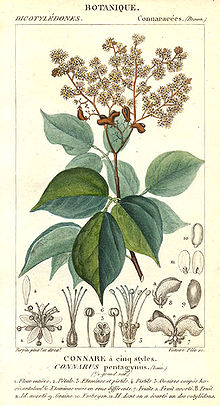
Meliaceae, the mahogany family, is a flowering plant family of mostly trees and shrubs in the order Sapindales.
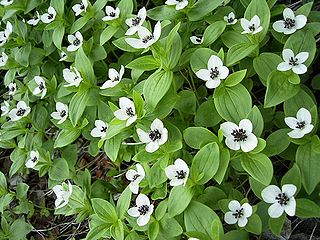
The Cornaceae are a cosmopolitan family of flowering plants in the order Cornales. The family contains approximately 85 species in two genera, Alangium and Cornus. They are mostly trees and shrubs, which may be deciduous or evergreen, although a few species are perennial herbs. Members of the family usually have opposite or alternate simple leaves, four- or five-parted flowers clustered in inflorescences or pseudanthia, and drupaceous fruits. The family is primarily distributed in northern temperate regions and tropical Asia. In northern temperate areas, Cornaceae are well known from the dogwoods Cornus.

The Anacardiaceae, commonly known as the cashew family or sumac family, are a family of flowering plants, including about 83 genera with about 860 known species. Members of the Anacardiaceae bear fruits that are drupes and in some cases produce urushiol, an irritant. The Anacardiaceae include numerous genera, several of which are economically important, notably cashew, mango, Chinese lacquer tree, yellow mombin, Peruvian pepper, poison ivy, poison oak, sumac, smoke tree, marula and cuachalalate. The genus Pistacia is now included, but was previously placed in its own family, the Pistaciaceae.

The Elaeagnaceae are a plant family, the oleaster family, of the order Rosales comprising small trees and shrubs, native to temperate regions of the Northern Hemisphere, south into tropical Asia and Australia. The family has about 60 species in three genera.

Lauraceae, or the laurels, is a plant family that includes the true laurel and its closest relatives. This family comprises about 2850 known species in about 45 genera worldwide. They are dicotyledons, and occur mainly in warm temperate and tropical regions, especially Southeast Asia and South America. Many are aromatic evergreen trees or shrubs, but some, such as Sassafras, are deciduous, or include both deciduous and evergreen trees and shrubs, especially in tropical and temperate climates. The genus Cassytha is unique in the Lauraceae in that its members are parasitic vines. Most laurels are highly poisonous.

Nothofagus, also known as the southern beeches, is a genus of 43 species of trees and shrubs native to the Southern Hemisphere in southern South America and east and southeast Australia, New Zealand, New Guinea, and New Caledonia. The species are ecological dominants in many temperate forests in these regions. Some species are reportedly naturalised in Germany and Great Britain. The genus has a rich fossil record of leaves, cupules, and pollen, with fossils extending into the late Cretaceous period and occurring in Australia, New Zealand, Antarctica, and South America.
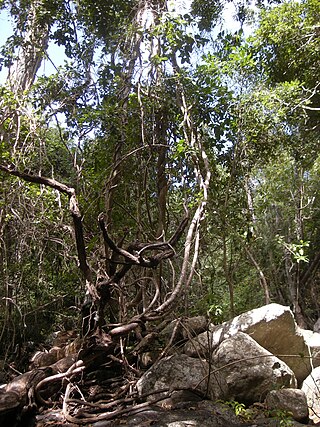
A liana is a long-stemmed, woody vine that is rooted in the soil at ground level and uses trees, as well as other means of vertical support, to climb up to the canopy in search of direct sunlight. The word liana does not refer to a taxonomic grouping, but rather a habit of plant growth – much like tree or shrub. It comes from standard French liane, itself from an Antilles French dialect word meaning to sheave.

Plumbaginaceae is a family of flowering plants, with a cosmopolitan distribution. The family is sometimes referred to as the leadwort family or the plumbago family.

The Oxalidaceae, or wood sorrel family, are a small family of five genera of herbaceous plants, shrubs and small trees, with the great majority of the 570 species in the genus Oxalis. Members of this family typically have divided leaves, the leaflets showing "sleep movements", spreading open in light and closing in darkness.

Castanopsis, commonly called chinquapin or chinkapin, is a genus of evergreen trees belonging to the beech family, Fagaceae. The genus contains about 140 species, which are today restricted to tropical and subtropical eastern Asia. A total of 58 species are native to China, with 30 endemic; the other species occur further south, through Indochina to Indonesia and the Philippines, mountainous areas of Taiwan, and also in Japan. The English name chinkapin is shared with other related plants, including the golden chinkapins of the Pacific United States, which are sometimes included within Castanopsis but are more often considered a separate but very closely related genus, Chrysolepis.
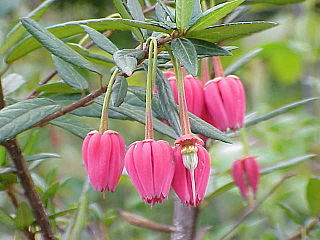
Elaeocarpaceae is a family of flowering plants. The family contains approximately 615 species of trees and shrubs in 12 genera. The largest genera are Elaeocarpus, with about 350 species, and Sloanea, with about 120.
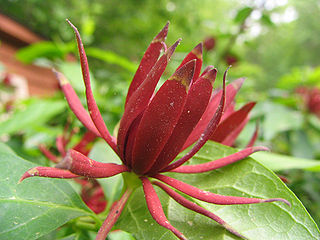
The Calycanthaceae are a small family of flowering plants in the order Laurales. The family contains three genera and only 10 known species, restricted to warm temperate and tropical regions:
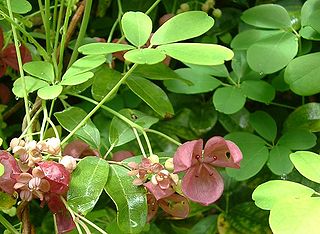
Lardizabalaceae is a family of flowering plants.

The Hernandiaceae are a family of flowering plants (angiosperms) in the order Laurales. Consisting of five genera with about 58 known species, they are distributed over the world's tropical areas, some of them widely distributed in coastal areas, but they occur from sea level to over 2000 m.

Sabiaceae is a family of flowering plants that were placed in the order Proteales according to the APG IV system. It comprises three genera, Meliosma, Ophiocaryon and Sabia, with 66 known species, native to tropical to warm temperate regions of southern Asia and the Americas. The family has also been called Meliosmaceae Endl., 1841, nom. rej.

Trochodendron is a genus of flowering plants with one living species, Trochodendron aralioides, and six extinct species known from the fossil record. It was often considered the sole genus in the family Trochodendraceae, though botanists now also include the distinct genus Tetracentron in the family.
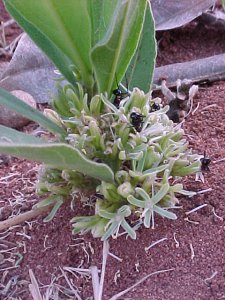
Dichapetalaceae is a family of flowering plants, consisting of 3 genera and about 170 species. Members of this family are trees, shrubs or lianas found in tropical and subtropical regions of the world.

The Cyrillaceae are a small family of flowering plants in the order Ericales, native to warm temperate to tropical regions of the Americas. The family comprises two genera, Cliftonia and Cyrilla, each containing a single species, Cliftonia monophylla and Cyrilla racemiflora. However, additional species of Cyrilla are now often recognized and the genus is in need of taxonomic revision.

Iteaceae is a flowering plant family of trees and shrubs native to the eastern USA, southeastern Africa, and south and Southeastern Asia. Some older taxonomic systems place the genus Itea in the family Grossulariaceae. The APG III system of 2009 includes the former Pterostemonaceae in Iteaceae. Consequently, it now has two genera with a total of 18 known species.
The Cucaracha Formation (Tca) is a geologic formation in Panama. It preserves vertebrate and plant fossils dating back to the Neogene period; Early to Middle Miocene epochs (Hemingfordian). Fossils of the crocodylian Centenariosuchus, the turtle Rhinoclemmys panamaensis and the artiodactyl Paratoceras have been found in the formation.
